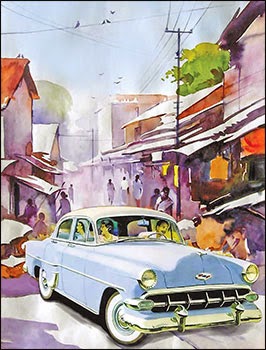The short story Interpreter of
Maladies by Jhumpa Lahiri is a post modernism piece. The human relationships
and human behavior are shown through the Das family and Mrs. Kapasi in the
story. The author uses objects around them and external surrounding that they
experience in their journey to express the mood of the characters and their
complex relationship. Mr. Kapasi believes that his life is a failure. His
career dreams are sacrificed for his family’s well being. His wife is grieving
over their dead son and she does not support him in any way. Even though he is
longing for companionship, he was able to accept his flaws in his career and
married life. Even though he does not like his job he is sincere to his job and
does it with perfection. Lahiri describes how he locks the door: “Reaches back
to make sure the cranklike locks on the sides of each of the back doors were
secured” (Lahiri 15).
Mrs. Das does not
seem to care about her surroundings. She does not care about her husband or her
children. She is burdened with regret and a secret for eight years which she
longs to share with someone. She seems more interested in external objects like
nail polish, gum and puffed rice. She suddenly shows an interest in Mr. Das
only because he is an interpreter. She assumes that he can help her with her
issue. When Mrs. Das asks Mr. Das a question” what are you saving us, fifty
cents?”(Lahiri 16) Mrs. Das ignores her and continues his conversation with Mr.
Kapasi. Mr. Das appears more interested in his camera than his wife. When Mrs.
Das refuses to come out of the car to visit the hills, he says “but we could
use one of these pictures for our Christmas card this year.” He asks her to
come not because he wants her to be there, but for a family photo. Mr. Das
tries to cover up his problem with his wife and pretends to be normal and happy
with his wife.
The
environment and setting helps the reader to understand the mood of the
characters. It is a hot and sunny day, and Mrs. Das is unhappy about this. The
sculptures in the sun temple create romantic and sexual tension between Mr.
Kapasi and Mrs. Das. Though he had already been to the temple, he gazes at the
topless female sculptures in the temple, because of the romance he feels with
Mrs. Das. The
author briefly describes the costume of each character in the story to show their
personality. “The family looked Indian but dressed as foreigners.” (Lahiri 13)
This shows that they were more American in personality than Indian. Mr. Das is
described to be wearing simple clothes so that the camera around the neck was
the only complex thing he wore. This shows that Mr. Das is a normal family
person. Mr. Kapasi wears a perfect uniform which he usually wears when going on
a tour and even mentions cut and fabric to the tailor, so the uniform does not
get crushed during travel. All this show that he is organized and truthful to
his job even though he thinks his job is a failure. When Mr. Kapathi observes
Mrs. Das, she is described wearing blouse with print of strawberry, which may
symbolizes desire to Mr. Kapasi.
The external
objects around the story symbolize the mood and behavior of each character in
the story. The puffed rice that Mrs. Das carries may represent the secret that
Mrs. Das was carrying for eight years. She was not ready to share the puffed
rice with anyone else except with Mr. Kapasi at the hills, and asks Mr. Kapasi,
“Want some?” (Lahiri, 25) Just like her secret that she was unable to share
with anyone else but with Mr. Kapasi as she believed he might suggest some
remedy. The monkeys that were around through the story represents Mrs. Das’s
emotions. At first the monkeys were calm but at the hills the strength of the
monkeys grew. As Mrs. Das dropped some of her puffed rice, it causes the
monkeys to become aggressive. This represents her secret causing her emotion to
come out as anger, which affects her son, Bobby. The fluttering of the paper
with Mr. Kapasi’s address represents the way Mr. Kapasi’s desire towards Mrs.
Das gets lost. The author uses symbolism in the story to provide the reader
with an understanding of the relationship issues, the complexions and
individuals human behavior. Clearly this piece is a work of post modernism.
